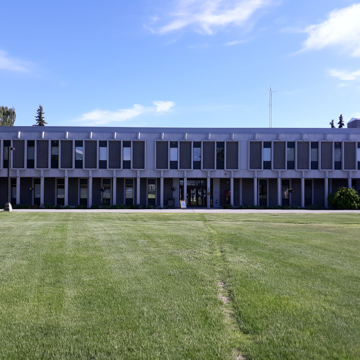Eugene Short Hall (ESH) was completed in 1967 and dedicated in 1972, named after the former director of the Anchorage Community College (ACC), which would eventually come to be known as the University of Alaska Anchorage (UAA). ESH is notable in that it was the first academic building constructed for what was then the community college. Today, Eugene Short Hall is home to the University’s Department of Health, Physical Education and Recreation, Parking Services, and the University of Alaska Anchorage Police. ESH may be entered from its south, where it connects to a limited parking lot, typically occupied by UAA police cruisers, or from the northern side, which faces the quad.
ESH is located at the center of the UAA Lucy Cuddy Quad on the west side of campus. It is centrally located around several other important UAA buildings, such as the Professional Studies Building, Lucy Cuddy Hall, and Sally Monserud Hall. Along with ESH, these academic and administrative buildings composed the original campus and are uniform in their style and building compositions. ESH connects to the quad through a concrete walkway and an open grass common area that is decoratively landscaped with flowerbeds, shrubbery, and sculptures. The immediate surroundings of the building are popular with students to gather and study on temperate Alaska days.
Constructed in the 1960s and early 1970s, the buildings along the Lucy Cuddy Quad are precast concrete and contain tilt-up panels. The windows are generally small, and grey concrete columns dominate the facade. The building is starkly composed and utilitarian in its appearance. It is a modern building and reflects the style of Minoru Yamasaki, Ed Stone, and Paul Rudolph usually referred to as 'New Formalism.' Like many of the community college's first buildings, the ESH was designed by architectural firm McEntire and Pendergast. Characteristic of this style, ESH has an exterior colonnade that creates a covered walkway on four sides; the framed panels, with their oversized "keystone" frame a blind arcade.
The buildings of the Lucy Cuddy Quad, along with much of the adjacent campus of Alaska Pacific University, one finds the highest concentration of midcentury architecture in Anchorage. As many of the buildings along the quad underwent renovations in the early 2000s, ESH has troubled architects due to its inflexible design and location. Still, the interior received a cosmetic renovation over the summer and fall of 2017, with new carpet and paint throughout. The classrooms have been updated to more adequately facilitate distance learning. So too have the offices for faculty and staff. However, at least one architectural firm concluded that ESH has reached the end of its useful life and would be a good candidate to be replaced. But given the financial constraints that the university has recently faced, there are no plans to demolish or significantly update ESH.
References
W.A. Jacobs, Becoming UAA: 1954-2014 The Origins and Development of the University of Alaska (Anchorage, AK: University of Alaska Anchorage, 2014).
University of Alaska Anchorage Campus Facilities Master Plan, 2004. Zimmer, Gunsul, Frasca Partnership (Portland, OR, 2003).

